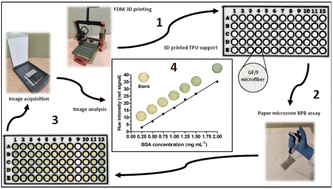Paper microzone assay embedded on a 3D printed support for colorimetric quantification of proteins in different biological and food samples†
Abstract
This study describes the development of a paper microzone colorimetric assay embedded on a 3D printed support for quantifying total protein content in different biological matrices and foods. The aim was to develop an accurate and reliable method, ensuring at the same time the possibility of customizability, facility of use, wide applicability, and reduced analysis for both time and costs. The device consists of a 3D printed thermoplastic polyurethane support housing the detection substrate (GF/F glass microfiber). The bromophenol blue (BPB) assay was optimized in this substrate to quantify total protein content. The analytical performance, assessed through image analysis, indicated that the hue factor of the HSV colour space represents the best analytical signal (r2 > 0.98%). The optimized assay ensures a sufficiently low limit of detection (0.05 mg mL−1), and an accuracy between 92% and 95%. The bioanalytical feasibility was demonstrated through total protein concentration measurement in different biological matrices (bee venom and mouse brain tissue), and foods (soya milk, cow's milk and protein supplements). The obtained values showed a strong agreement with those derived from a standard spectrophotometric analysis. Overall, the paper microzone BPB assay may represent an important contribution to protein quantification technology and could significantly impact many areas, such as quality control analysis and pre-clinical laboratory analysis.

- This article is part of the themed collection: Analytical Methods HOT Articles 2023


 Please wait while we load your content...
Please wait while we load your content...